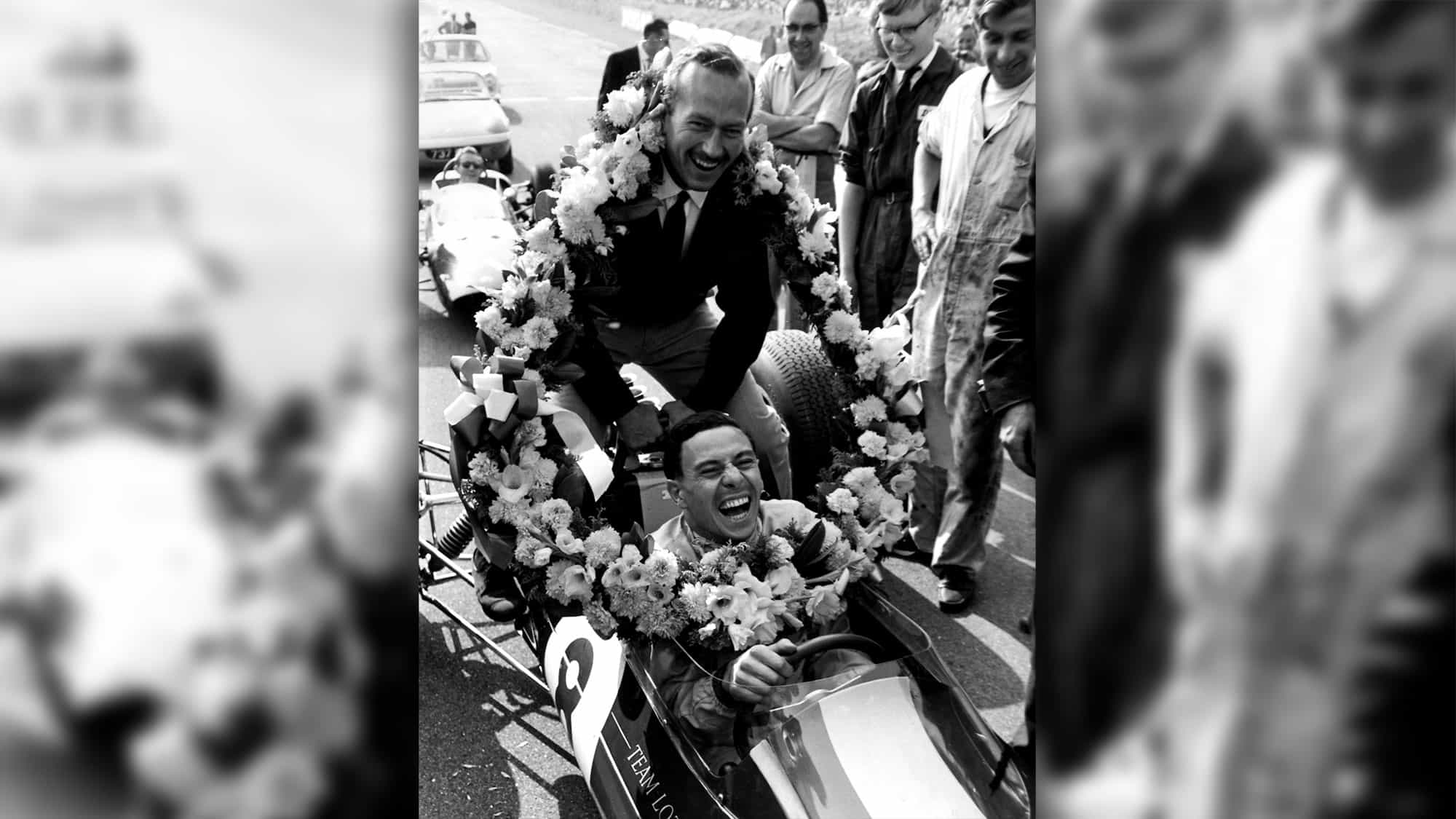How Jim Clark drew Colin Chapman’s attention
Paul Fearnley looks at a how a damp day in Kent shaped a legend

Jim Clark and Colin Chapman became a combination that would change the face of the sport
Getty Images
Taken from Motor Sport, December 2014, How Clark drew Chapman’s attention
I finally got going after a push and spent a dismal race in the middle of the pack… unable to think much save that Boxing Day was a crazy day to go motor racing.”
Fair to say Jim Clark didn’t enjoy his single-seater debut. No doubt it was coloured by what had happened earlier. Having decided to settle for second behind the sister Lotus Elite of Graham Warner in the Production Sports Car race, he lost concentration – some say a rear hub broke – and spun backwards into a bank. It was his first crash. And his last outing in a car owned by friend and mentor Ian Scott Watson.
This meeting was in every sense a turning point for Clark – and for the sport. He had for two seasons wrestled his conscience: the steady but heavy demands of the family and its farm versus the exotic, quickening lure of motorsport.
Notoriously bad at making decisions, he allowed himself to be talked round by racing friends after “frightening myself silly” in a Jaguar D-type at Spa in 1958. Those same people would have to pick him up after his disastrous Boxing Day Brands Hatch of 1959.
Warner kept the faith. Looking to expand his West London business, The Chequered Flag, he’d invited Clark to race a Formula Junior. The Gemini MkII was based on the Moorland MkI constructed in nearby Southall by Les Redmond, from a scheme by freelance designer Len Terry. Warner bought the rights and employed Redmond. A neat front-engine machine with a spaceframe chassis, Clark’s was powered by a Speedwell-tuned BMC A-Series ‘four’.
Oddly, given his pencil-slim Lotus recliners to come, Clark complained about its cramped cockpit. His mood only darkened when the Gemini’s battery died on the grid. Alongside him was Alan Stacey in the unpainted prototype Lotus 18 – Colin Chapman’s first rear-engined racing car: “A cigar tube with four wheels,” reckoned Clark. Others called it “a biscuit tin”. It was fitted with a bitsa Ford 105E engine cobbled by Cosworth from its original standard unit and the remains of the tuned item that had locked solid due to a loose flywheel and caused Warner to crash his Gemini in practice.
The unsorted Lotus handled badly in the wet – though its suspension was sufficiently soft for it to ground over bumps – and Clark reckoned it an accident-in-waiting. His prediction almost came true when Stacey spun and nudged the bank.
The works Elva of Peter Arundell won despite its Mitter-tuned DKW two-stroke appearing to tighten near the finish. This allowed the brand-new works Lola of Peter Ashdown to close within 0.4sec after prevailing in a dice with Arundell’s team-mate Chris Threlfall. Clark finished a despondent eighth behind Mike McKee’s Cooper, another brand-new model – Britain was finally discovering its Junior mojo – the Elva-BMCs of Chris Lawrence and pole-sitter Bill de Selincourt, who spun on the first lap, and another Cooper. It could have been worse – but not by much: Stacey was 10th after his moment.
Matters had run late but more smoothly 12 months previously. Having received a Christmas Eve phone call from Chapman that his pre-production Elite was ready, Scott Watson rounded up Clark and they boarded the overnight express to London.
Having spent a sober Christmas Day night sleeping fitfully on the train, they collected the car from outside Green Park Hotel, drove it to Brands Hatch, taped its headlights and went racing.
Clark’s prior experience of the Kent circuit was a Lotus F2 test. He did reasonably well during two runs but decided against purchase after it shed a wheel, rolled and flung Graham Hill from its cockpit.
Clark was happier in sports racers and GTs and delighted in the nimble Elite that he sampled that same day.
Chapman was already impressed by the shy Scot but had no inkling of what was to come at Boxing Day Brands.
Their dice in the 10-lap up-to-1500cc GT race was epic, Clark’s progress being more agricultural than usual. Motor Sport’s report by Bill Boddy noted J Clark’s “enormous verve” and remarked: “There are no stupid ‘no wheels off the road’ rules at Brands.”
One story goes that Clark was incensed having heard Chapman and Mike Costin chatting in the gents’ lav about how they would carve up the race in their works Elites.
“If I had known what I know now,” he wrote in his 1964 book Jim Clark at the Wheel, “I wouldn’t have done half of the things I did in that race. I have photographs of us going side by side round Paddock Bend, both with cars sideways on.”
His white car was leading and pulling away with a few laps left when he was baulked by a backmarker. This delay allowed the opportunistic and determined Chapman to nip though on the inside at Druids and win by 1.6sec.
Chapman, who had a high regard for his own driving prowess, was convinced now that Clark’s was a special talent. Within three months the combination of Chapman, Clark and Cosworth, plus a much-improved Junior Lotus 18, would begin rewriting the single-seater canon. Christmas came early in 1960: on March 19, at Goodwood.Clark never settled for second again.
